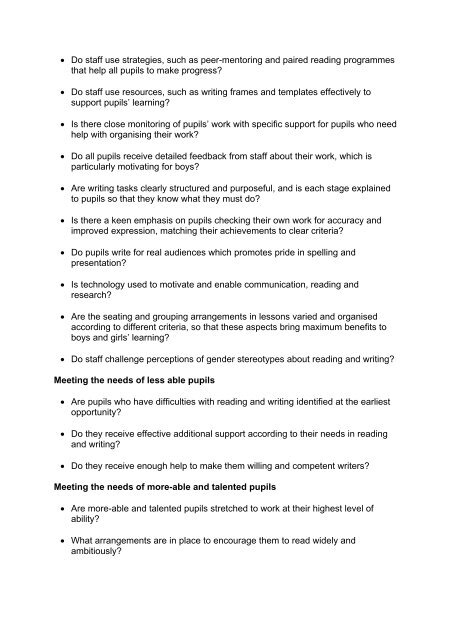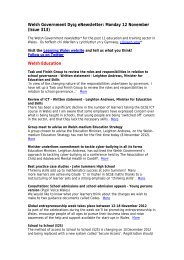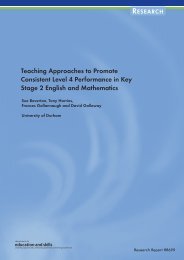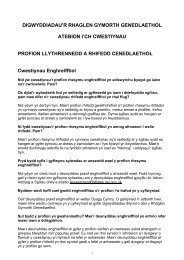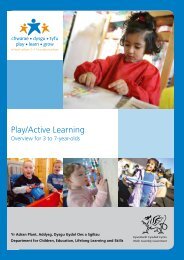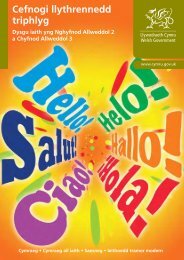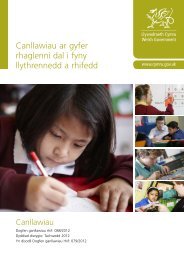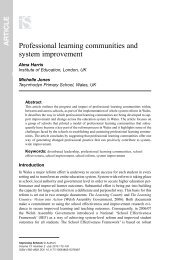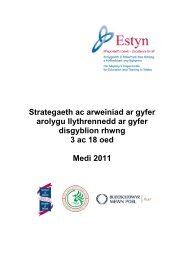Best practice in the reading and writing of pupils aged 7 to 14 ... - Estyn
Best practice in the reading and writing of pupils aged 7 to 14 ... - Estyn
Best practice in the reading and writing of pupils aged 7 to 14 ... - Estyn
You also want an ePaper? Increase the reach of your titles
YUMPU automatically turns print PDFs into web optimized ePapers that Google loves.
• Do staff use strategies, such as peer-men<strong>to</strong>r<strong>in</strong>g <strong>and</strong> paired read<strong>in</strong>g programmesthat help all <strong>pupils</strong> <strong>to</strong> make progress?• Do staff use resources, such as writ<strong>in</strong>g frames <strong>and</strong> templates effectively <strong>to</strong>support <strong>pupils</strong>’ learn<strong>in</strong>g?• Is <strong>the</strong>re close moni<strong>to</strong>r<strong>in</strong>g <strong>of</strong> <strong>pupils</strong>’ work with specific support for <strong>pupils</strong> who needhelp with organis<strong>in</strong>g <strong>the</strong>ir work?• Do all <strong>pupils</strong> receive detailed feedback from staff about <strong>the</strong>ir work, which isparticularly motivat<strong>in</strong>g for boys?• Are writ<strong>in</strong>g tasks clearly structured <strong>and</strong> purposeful, <strong>and</strong> is each stage expla<strong>in</strong>ed<strong>to</strong> <strong>pupils</strong> so that <strong>the</strong>y know what <strong>the</strong>y must do?• Is <strong>the</strong>re a keen emphasis on <strong>pupils</strong> check<strong>in</strong>g <strong>the</strong>ir own work for accuracy <strong>and</strong>improved expression, match<strong>in</strong>g <strong>the</strong>ir achievements <strong>to</strong> clear criteria?• Do <strong>pupils</strong> write for real audiences which promotes pride <strong>in</strong> spell<strong>in</strong>g <strong>and</strong>presentation?• Is technology used <strong>to</strong> motivate <strong>and</strong> enable communication, read<strong>in</strong>g <strong>and</strong>research?• Are <strong>the</strong> seat<strong>in</strong>g <strong>and</strong> group<strong>in</strong>g arrangements <strong>in</strong> lessons varied <strong>and</strong> organisedaccord<strong>in</strong>g <strong>to</strong> different criteria, so that <strong>the</strong>se aspects br<strong>in</strong>g maximum benefits <strong>to</strong>boys <strong>and</strong> girls’ learn<strong>in</strong>g?• Do staff challenge perceptions <strong>of</strong> gender stereotypes about read<strong>in</strong>g <strong>and</strong> writ<strong>in</strong>g?Meet<strong>in</strong>g <strong>the</strong> needs <strong>of</strong> less able <strong>pupils</strong>• Are <strong>pupils</strong> who have difficulties with read<strong>in</strong>g <strong>and</strong> writ<strong>in</strong>g identified at <strong>the</strong> earlies<strong>to</strong>pportunity?• Do <strong>the</strong>y receive effective additional support accord<strong>in</strong>g <strong>to</strong> <strong>the</strong>ir needs <strong>in</strong> read<strong>in</strong>g<strong>and</strong> writ<strong>in</strong>g?• Do <strong>the</strong>y receive enough help <strong>to</strong> make <strong>the</strong>m will<strong>in</strong>g <strong>and</strong> competent writers?Meet<strong>in</strong>g <strong>the</strong> needs <strong>of</strong> more-able <strong>and</strong> talented <strong>pupils</strong>• Are more-able <strong>and</strong> talented <strong>pupils</strong> stretched <strong>to</strong> work at <strong>the</strong>ir highest level <strong>of</strong>ability?• What arrangements are <strong>in</strong> place <strong>to</strong> encourage <strong>the</strong>m <strong>to</strong> read widely <strong>and</strong>ambitiously?


